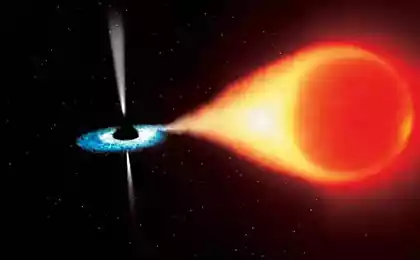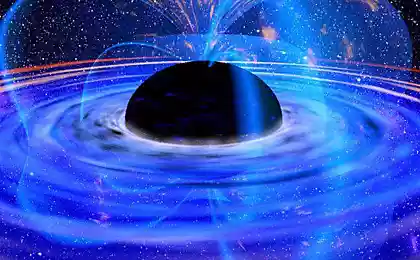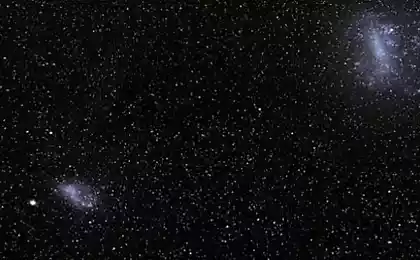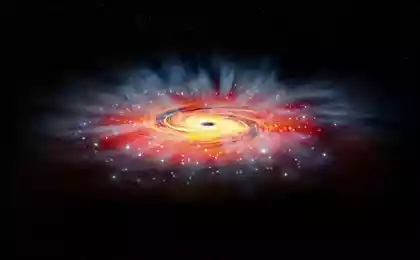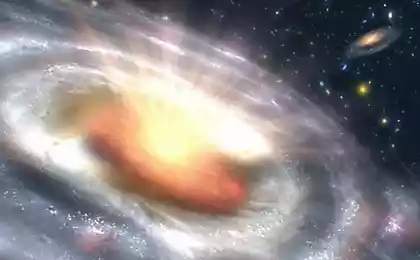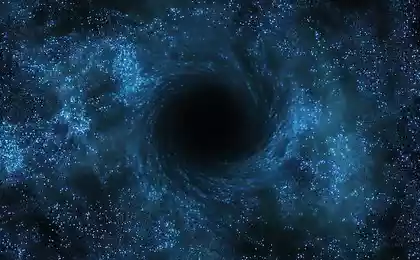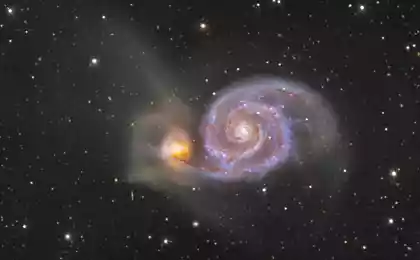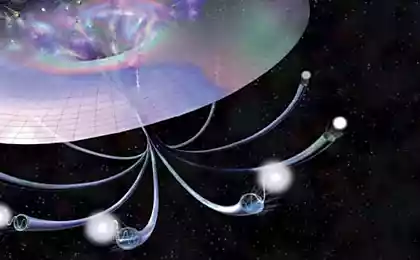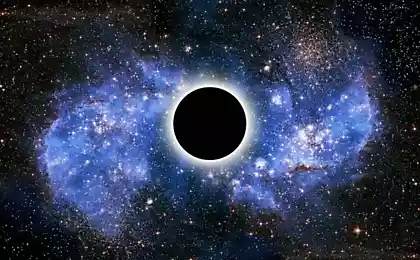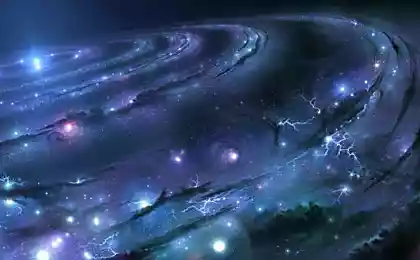825
Magnetar near the supermassive black hole behaves strangely
7,475,790
Photo: NASA / CXC / INAF / F.Coti Zelati et al i>
In 2013, astronomers announced that they have discovered magnetar incredibly close to a supermassive black hole at the center of the Milky Way (assumed that supermassive black holes exist at the center of many galaxies). Discover the star was due to several telescopes in orbit, including space X-ray observatory "Chandra».
Magnetar - destroyed (neutron) stars with extremely powerful magnetic field (up to 10 11 sup> T).
Seen in 2013 magnetar SGR 1745-2900 located at a distance of 0, 3 light-years from the edge of a black hole with a mass of 4 million solar masses at the center of our galaxy. Today it is the nearest to the supermassive black hole, a neutron star, which scientists have discovered. Perhaps she even under the gravitational influence of the black hole, that is, in curved space-time.
Since the discovery two years ago, when the first wave of the radiation received from the magnetar, astronomers carefully watching him via observatory "Chandra" and X-ray telescope XMM-Newton of the European Space Agency.
The illustration shows a section near the top of the black hole, the resulting X-rays, "Chandra." Red, green and blue colors correspond to low, medium and strong X-ray emission, respectively. On separate inset shows part of the photo, where there was a magnetar. Photo left combination in 2005-2008, where he was to be seen. On the right picture of 2013, when he was received radiation pulse magnetar, which led to the discovery.
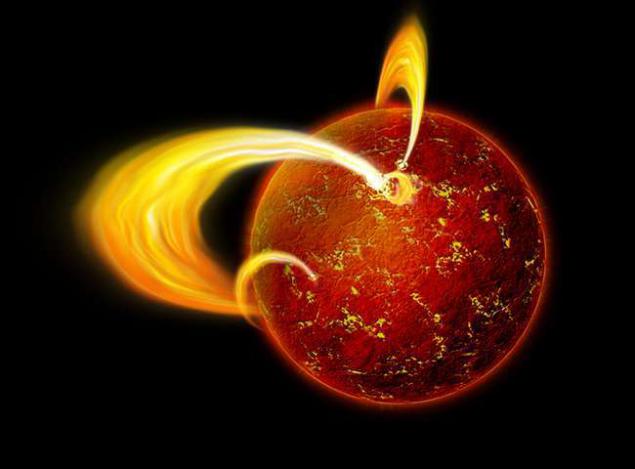
a rapidly rotating neutron star generates a powerful magnetic field i>
Two years of observation of the object shown that X-ray emission from SGR 1745-2900 falls faster than that of other known magnetars, and its surface is hotter than expected.
A group of scientists, which explores the SGR 1745-2900, scientific publications , which gives the results of research and brings the version with which may be linked unexpected properties of a magnetar.
One theory is that the surface of the magnetar could undergo a powerful "zvёzdotryaseniyam" (by analogy with earthquakes). When formed neutron star, she can be formed on the surface of a thick crust. Sometimes this crust can crack as the Earth's crust during earthquakes
Although zvёzdotryaseniya explain changes in brightness and rapid cooling of many magnetars, but they can not explain the slow decline in X-ray SGR 1745-2900, wrote the scientists, as well as an abnormally high temperature of the crust. When star- everything should be faster, but here goes too slow.
The researchers suggest that the bombardment of the surface of the magnetar charged particles stuck in the tangled knots of magnetic fields on the surface of the magnetar, can provide additional heating of the surface and explain the slow decline of X-rays.
Scientists do not believe that the properties of the magnetar caused by its proximity to the supermassive black hole, since the distance to 0, 3 light-years still too large for a stable interaction through magnetic fields, or gravity.
Watching object SGR 1745-2900 will continue to collect new data and explain his unusual behavior.
In materials site space X-ray observatory "Chandra» i>
Source: geektimes.ru/post/250426/
Photo: NASA / CXC / INAF / F.Coti Zelati et al i>
In 2013, astronomers announced that they have discovered magnetar incredibly close to a supermassive black hole at the center of the Milky Way (assumed that supermassive black holes exist at the center of many galaxies). Discover the star was due to several telescopes in orbit, including space X-ray observatory "Chandra».
Magnetar - destroyed (neutron) stars with extremely powerful magnetic field (up to 10 11 sup> T).
Seen in 2013 magnetar SGR 1745-2900 located at a distance of 0, 3 light-years from the edge of a black hole with a mass of 4 million solar masses at the center of our galaxy. Today it is the nearest to the supermassive black hole, a neutron star, which scientists have discovered. Perhaps she even under the gravitational influence of the black hole, that is, in curved space-time.
Since the discovery two years ago, when the first wave of the radiation received from the magnetar, astronomers carefully watching him via observatory "Chandra" and X-ray telescope XMM-Newton of the European Space Agency.
The illustration shows a section near the top of the black hole, the resulting X-rays, "Chandra." Red, green and blue colors correspond to low, medium and strong X-ray emission, respectively. On separate inset shows part of the photo, where there was a magnetar. Photo left combination in 2005-2008, where he was to be seen. On the right picture of 2013, when he was received radiation pulse magnetar, which led to the discovery.

a rapidly rotating neutron star generates a powerful magnetic field i>
Two years of observation of the object shown that X-ray emission from SGR 1745-2900 falls faster than that of other known magnetars, and its surface is hotter than expected.
A group of scientists, which explores the SGR 1745-2900, scientific publications , which gives the results of research and brings the version with which may be linked unexpected properties of a magnetar.
One theory is that the surface of the magnetar could undergo a powerful "zvёzdotryaseniyam" (by analogy with earthquakes). When formed neutron star, she can be formed on the surface of a thick crust. Sometimes this crust can crack as the Earth's crust during earthquakes
Although zvёzdotryaseniya explain changes in brightness and rapid cooling of many magnetars, but they can not explain the slow decline in X-ray SGR 1745-2900, wrote the scientists, as well as an abnormally high temperature of the crust. When star- everything should be faster, but here goes too slow.
The researchers suggest that the bombardment of the surface of the magnetar charged particles stuck in the tangled knots of magnetic fields on the surface of the magnetar, can provide additional heating of the surface and explain the slow decline of X-rays.
Scientists do not believe that the properties of the magnetar caused by its proximity to the supermassive black hole, since the distance to 0, 3 light-years still too large for a stable interaction through magnetic fields, or gravity.
Watching object SGR 1745-2900 will continue to collect new data and explain his unusual behavior.
In materials site space X-ray observatory "Chandra» i>
Source: geektimes.ru/post/250426/
Do not relax
What is the summary of the technical university graduate engineer in the position SpaceX
